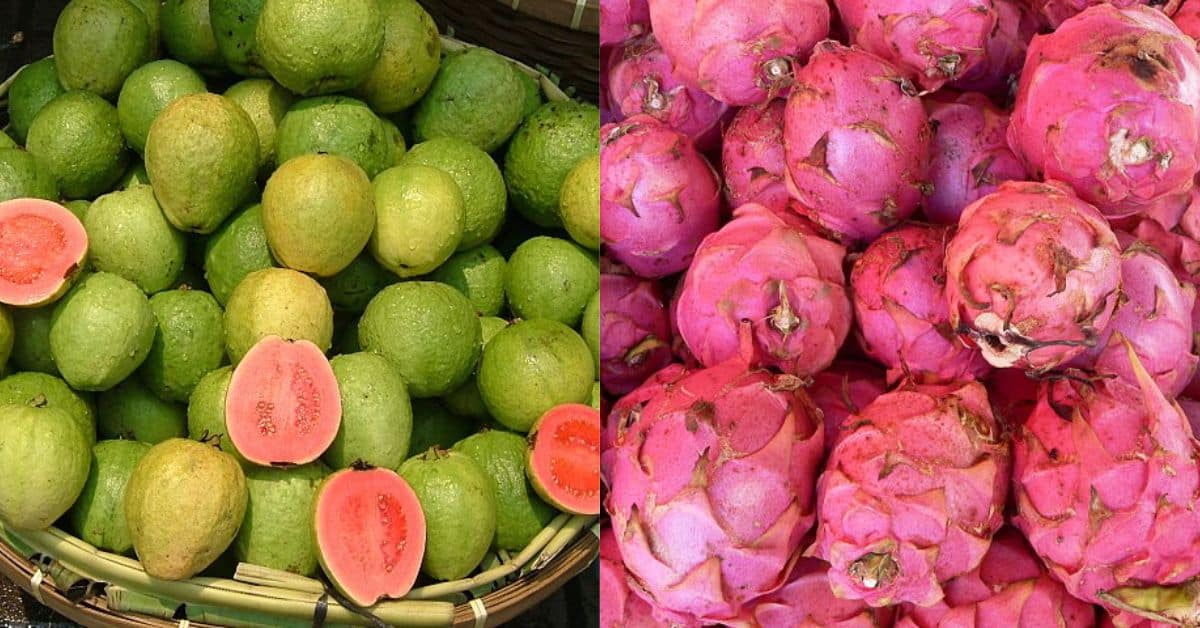Colombia is home to over 1,000 different fruit species, ranging from familiar favorites to unique, exotic and celebrated super fruits. You can experience incredible and unexpected flavors and textures for the first time in your life during a trip to Medellin’s minorista.
In this article I will discuss some of the best Colombian fruits you can try here for the first time. I will look at how to enjoy them, where they come from, why they are important and some of the incredible health benefits they can offer.
Exotic and delicious Colombian fruits
Uchuva

Uchuva’s are small, round, orange fruits that grow inside a thin, dry leaf. The flavor is bittersweet and there are small, edible seeds inside. They are between 1.5 to 2.5m in diameter with the texture of a firm berry.
The scientific name is Physalis Peruviana and they are also known as aguaymanto or uvilla in Latin America or Cape gooseberry, goldenberry and Peruvian groundcherry in the English speaking parts of the world. The history of cultivation dates back to the Inca Empire and they were introduced to England in the 18th century.
The fruit can be made into sauces, pies, puddings, chutney, and jam or eaten fresh in salads and fruit salads. Unripe uchuva can be potentially toxic but you shouldn’t have any issues with what you can find on sale in Colombia. One of the more popular Colombian fruits.
Pitaya
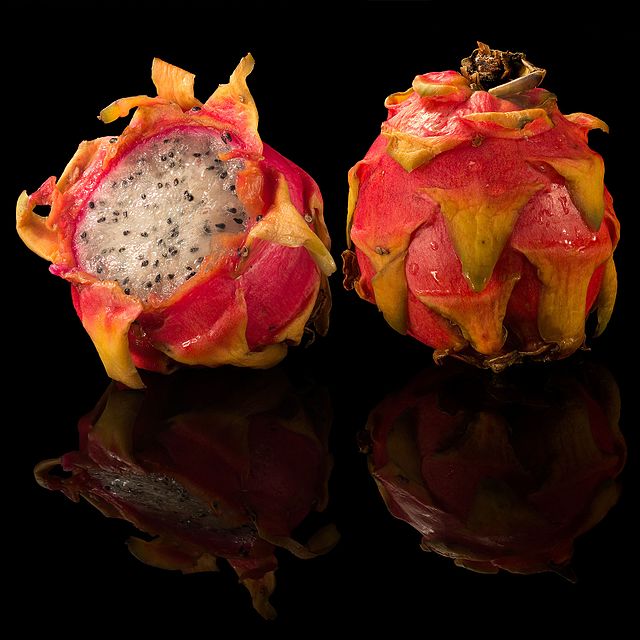
Pitaya, or ‘dragon fruit’ in English, has a subtle sweet taste which has hints of kiwi, pear, and melon. The shell is firm and inside it has a texture like a passion fruit with edible seeds.
You can cut it in half to eat the pulp with a spoon or cut it into pieces and remove the hard skin with your hand. The fruit is low in calories and is a good source of Vitamin C. Pitaya is used for juices, smoothies, or desserts and the strong color can be the basis for natural food coloring.
Pitaya is found all around the world in tropical and sub-tropical conditions but in Colombia, they are mostly cultivated in the regions of Boyacá, Quindío, Santander, and Valle del Cauca. This is one of the most unusual of all Colombian fruits.
Lulo
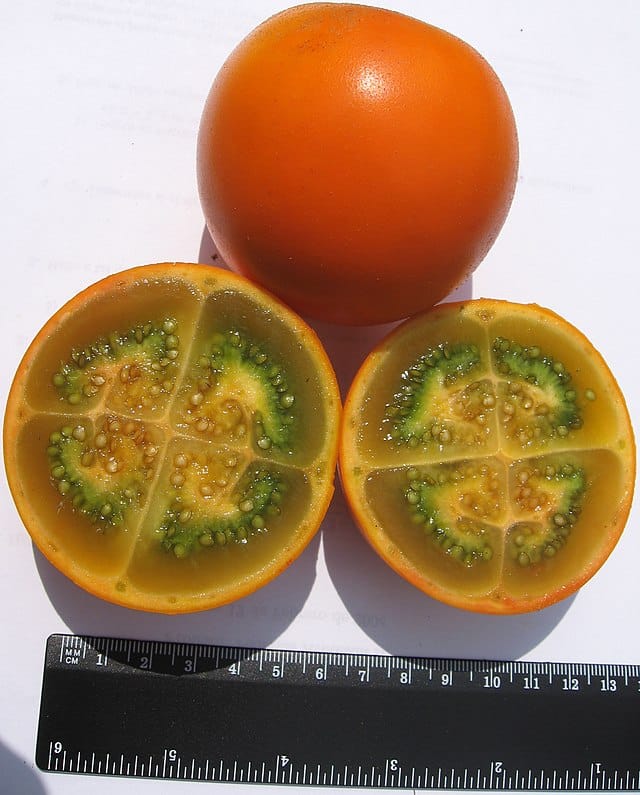
Lulo’s look like small oranges but have a tart, citrus flavor. The skin is orange on the outside and inside the juice of the fruit is green. It is not a fruit that is tasty to eat on its own but they can make really tasty, refreshing juices which you will find all over Colombia. Lulo can also be used in jams, ice creams, and fruit sauces. If you get the set lunch menu in Medellin there is a good chance that Lulo will be one of your drink options.
They are known as naranjilla in Ecuador, Costa Rica but Colombians use the traditional Quechua word Lulo. The scientific name is solanum quitoense, meaning “from Quito”, a hint to its origins. The small trees are particularly delicate to wind and strong son while the fruits can easily be damaged during transportation which means they are rarely found outside of Colombia, Costa Rica, or Ecuador. One of the Colombian fruits that is a local favorite that most people will never get to try.
Maracuyá
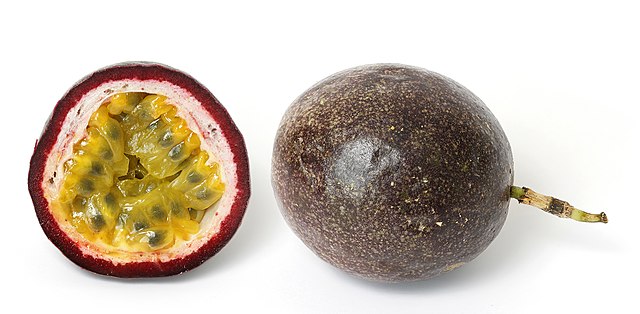
Maracuyá is known as parchita in Venezuela, parcha in Puerto Rico, Maracuja in Brazil, or pasionaria in Paraguay while in English it is called passionfruit. There are a few varieties of passionfruit in Colombia, such as the next fruit in this list, but maracuyá is the most popular and well-known.
The fruit is a wrinkly, oval shape and to prepare you should cut it open and remove the seeds that are covered in jelly. It is best enjoyed in juices or as a tart ice cream. Maracuyá is a good source of vitamin C, which is a natural sedative and can aid digestion. You can tell it is ripe when the outside is completely yellow and slightly wrinkled.
Gulupa
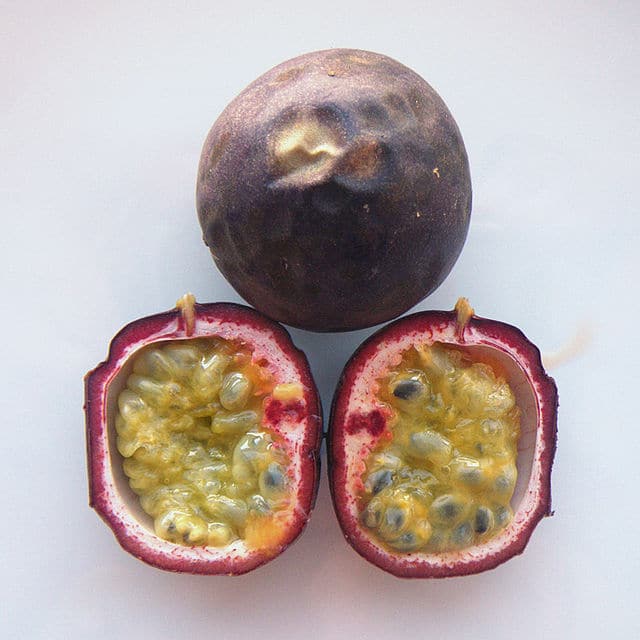
The gulupa is the cousin of the more well-known maracuya and is part of the passionfruit family. The outer shell is smooth and thick with a distinct purple color. Inside the juicy yellow pulp has an unusual sweet and sour flavour.
An excellent source of vitamin C it is also reportedly good to help regulate dreams and control tension. You can tell it is ripe when the dark skin becomes wrinkled. It can eaten as is or you can use it in juices, smoothies, or sauces.
Guava
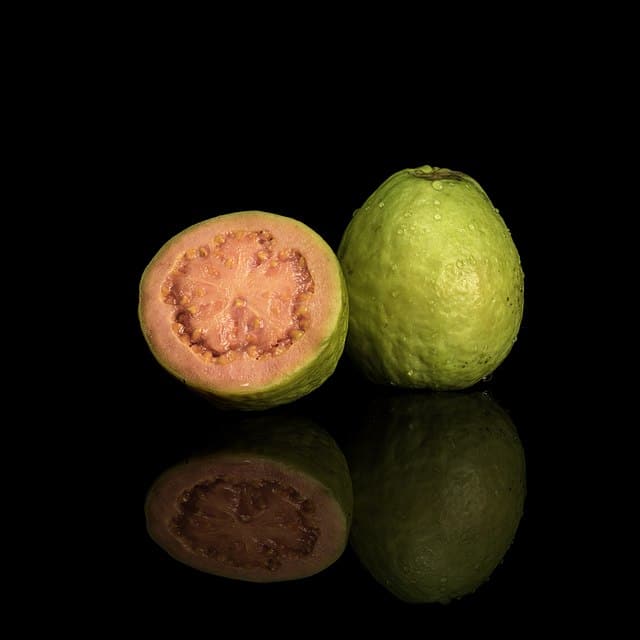
Guava is green on the outside and pink inside with tiny, edible seeds. They are soft and sweet when ripe with a rounded or pear shape. The pulp of guava is used as the basis of bocadillo, a popular and traditional sweet snack that comes in a small brown block wrapped in a bijao leaf.
Guava can be eaten raw or included in juices, salads, and jams. They are a great source of vitamin A, vitamin C, folate, fiber, thiamine, and riboflavin. Guava has been described as a superfruit given it is low in calories and high in nutrients. Health professionals have claimed guava can help improve heart health and immune function, stabilize blood sugar levels, and reportedly support male fertility.
One of the healthiest of all Colombian fruits.
Guanábana
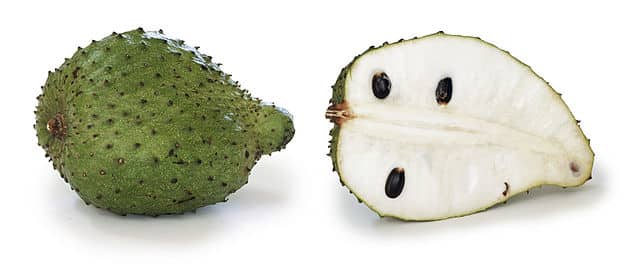
Guanábana is known as soursop in English-speaking parts of the world. It is a large green fruit with short, prickly spines covering the skin. You can cut it in half and remove the seed, then enjoy the white pulp which has a slightly sweet flavor. You can eat with your hand or include in smoothies and desserts.
Guanábana is a good source of fiber and vitamins. The trees take 4 years before they start producing fruit and have a lifespan of around 30 years. They are grown close to Medellin in the Antioquia region as well as in Tolima, Caldas, Huila, Santander, Risaralda, and Valle de Cauca.
borojó
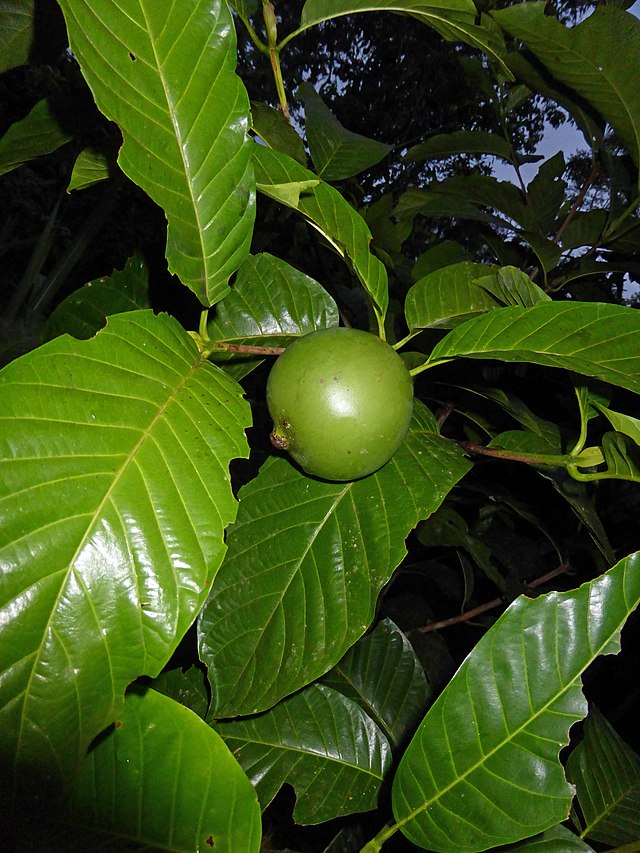
The borojó is a pretty incredible little fruit. Around 12% of the fruit is its thin, firm outer layer which can be green or brown while the flesh inside can be brown or white. The fruit comes from the Pacific coast of Colombia and has been an important part of life for centuries. The fruit is even included as part of mortuary rituals in the region.
The power of the borojó is increasingly appreciated across the country and beyond. Known as “the fruit of love” or nature’s viagra” for its aphrodisiac properties, it is a great source of Vitamin B. As well as reportedly contributing to performance in the bedroom, it is also increasingly used by high-level athletes as a natural source of energy with protein, fiber, and vitamins. It has a fairly bitter taste so it is usually best to combine with other flavours in a very healthy juice.
Borojó is one of the Colombian fruits that are becoming increasingly popular with extensive health benefits and an important cultural importance.
Mamoncillo
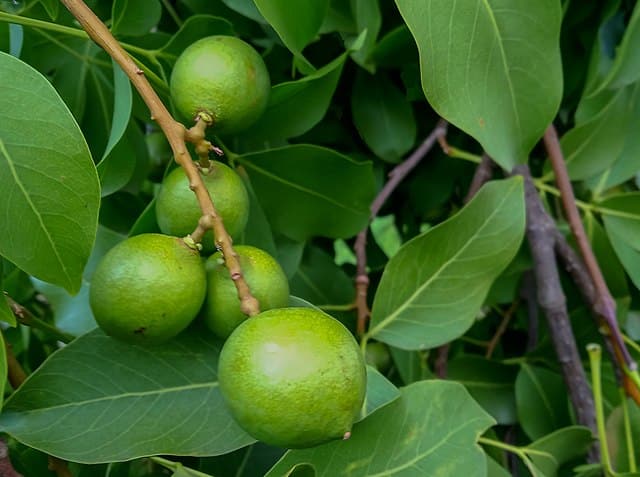
Mamoncillo are small green fruits that are usually round. They have thin, firm skin that can be peeled to reveal the flesh which is chewy similar to lychee. The flesh is tangy, acidic, and sweet and is best enjoyed by sucking until you reach the large central seed. They are like tasty natural gobstoppers which you can suck on until all of the flavor has gone.
The fruit comes from the North of the continent in Colombia, Venezuela, and the Caribbean. In Jamaica if a woman finds two seeds in her fruit then she is destined to have twins while in the Puerto Rican city of Ponce, there is a three-day festival to celebrate the fruit. They are a good source of vitamin A and vitamin C. They can also be used as a natural laxative and to help with digestive issues.
Curuba
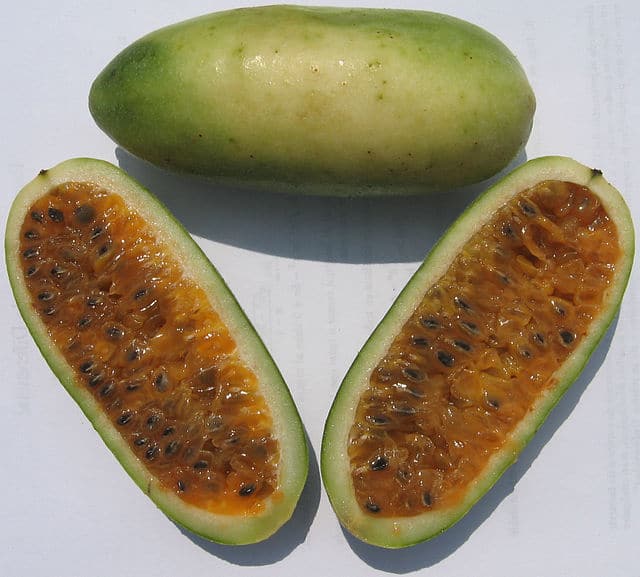
Curuba is often known as the ‘banana passionfruit’ and is now exported around the world. The fruit has the shape and color of a banana on the outside with a soft, juicy, dark yellow pulp on the inside similar to a passionfruit. The pulp is sweet, tart, and tangy with black seeds which are edible but can have a more bitter taste. Some people eat the seeds and some separate them.
The fruit can be added to yogurt or ice cream or mixed into fruit salads, james, or jellies. It can also add flavor to baked goods, cakes, or pies. In Colombia, it is used as the main ingredient in sorbete de Curuba with condensed milk, sugar, cream, and ice.
Mongosteen

Mongostino, or mongosteen in English, is a very unique fruit that has fascinated people for decades. The fruit has dark purple skin which is inedible but you can break it open to reveal a white, soft, sweet, tangy flesh inside. The flesh comes in six to eight segments.
The mongostino is known as the ‘Queen of the Fruit’ as English monarch Queen Elizabeth I reportedly offered a small fortune to anyone who could bring her the legendary purple fruit to try. Prices remain high today overseas as countries have import restrictions on mongosteen. You can eat them raw or use them in juices, smoothies, or sweet dishes at one of the many local Medellin restaurants. One of the more unique Colombian fruits.
Zapote

Zapote, or often sapote in English, is one of Colombia’s toughest and most resilient fruits. You can find them all over the country as they grow quickly and are resistant to drought and strong winds. They have thick, leathery brown skin with vibrant orange flesh and various inedible black seeds in the center.
The taste is like a sugar-covered sweet potato with a touch of caramel, cantaloupe and pumpkin. It can be eaten raw but it is often best in juices, milkshakes, and ice cream. You can also use it in baked goods or combine with honey. Zapote is high in fiber, vitamins, and minerals which can be good for your gut, skin, and heart.

